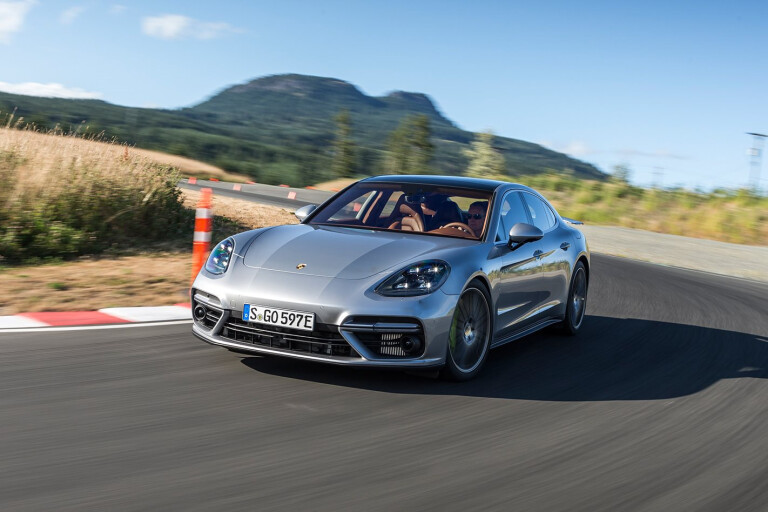
We grab a first drive in Porsche’s most potent Panamera to see if its new performance focus is as electrifying as its drivetrain.
TELL ME ABOUT THIS CAR
Porsche introduced the second-generation Panamera earlier this year with the six-variant range capped off by the $384,500 Turbo, but a new Turbo S E-Hybrid has joined the line-up blowing the price up to $460,100.
The new version uses the same 4.0-litre turbocharged V8 which sends power to all four wheels, but slots a 100kW motor into the eight-speed automatic transmission for a combination of more performance and better fuel efficiency.
In addition to the added performance and economy, the Turbo S also gains a healthy dose of extra equipment including carbon ceramic brakes, torque vectoring and Sport Chrono pack included.

As part of a broader Porsche perspective, the new Panamera flagship represents a new hybrid direction for the car maker and is the first time the most potent performer in any range has used electrification to beat combustion power alone.
STRENGTHS
- With V8 turbo and electric motor working in unison, the Panamera’s acceleration is blistering. All paw traction and a combined 850Nm allows the big limo to hit 100km/h in just 3.4 seconds.
- Despite the massive performance potential, up to 50km can be driven on electric-only power and plug-in recharging offers the possibility of petrol-free commuting. With 400Nm of electric motor torque, driving the Panamera as an electric car is effortless for most driving conditions and allows up to 140km/h cruising.
- The transition from electric only driving to petrol/electric is almost undetectable thanks to a silky V8 and sophisticated engine restart electronics.
- Dynamic performance is just as impressive as straight line speed and on twisty roads the big Porsche defies its 2.3-tonne kerb weight. Grip levels are high even in the tightest turns and, when fitted, the optional rear-wheel steering is very effective at disguising a 2950mm wheelbase. Sensitive steering allows precise positioning in the road and the small steering wheel offers plenty of feedback.
- Immense braking power completes the performance trifecta and 420mm carbon ceramic front discs resist fade even under track conditions, while the monstrous 10-piston calipers that grab them are among the biggest in the business.
- Away from dynamic roads, the softer ride settings turn the Panamera into an accomplished and comfortable limousine with a cosseting ride despite its 21-inch wheels. Minimal wind and road noise adds to the serene cabin environment.
- Interior quality and design is hard to beat and combines razor-sharp styling with beautiful materials for a first-class travel experience. Its massive central information and entertainment screen serves as an impressive but understated centrepiece, surrounded by a simplified centre console and switchgear.

- Acid Green highlights to exterior badging, brake calipers and gauge needles are a subtle but likeable reminder of the hybrid powertrain.
- Rear seat comfort equals the front row when optioned with eight-way power adjustable seats for two occupants, but standard three person row offers excellent comfort too with 60:40:60 split folding that boosts boot capacity from 405 litres to 1245L.
- Clever driving modes allow the hybrid system to work in different ways according to driving preference or journey requirements. In E mode, only battery power is called on unless fully discharged or the engine is restarted with a full-throttle prod. In H mode the engine and motor work together for maximum fuel efficiency and offers an option that will preserve the battery power for a later stage of the journey where zero emission driving will be required. S and S+ modes use the electric motor purely for a performance gain.
WEAKNESSES
- Unlike some EVs and hybrids, the Porsche has no regenerative braking effect on overrun and the brake pedal has to be touched to initiate the regeneration of electricity from deceleration. Brake pedal feel is relatively sensitive for a hybrid but could be improved by allowing regen on overrun.
- The hybrid system adds approximately 300kg to the weight of the petrol-only Turbo.
- Bespoke Michelin 21-inch rubber will hit the wallet hard when it comes to trips to the tyre shop.
- Hybrid system defaults to E mode each time the car is restarted and the drive mode selector must be turned to another mode if anything other than pure EV driving is required on each journey.
ANY RIVALS I SHOULD CONSIDER
There are very few options that can compete with both the Porsche’s electrified drivetrain and performance wrapped up in a four/five seat package but the Tesla Model S offers a pure EV option with the closest credentials.
With less of a performance focus, Mercedes offers the S500e and BMW has the 740e, while a pure performance focus without hybrid tech brings the Audi RS7 and Mercedes-AMG CLS 63 into the competition.


COMMENTS